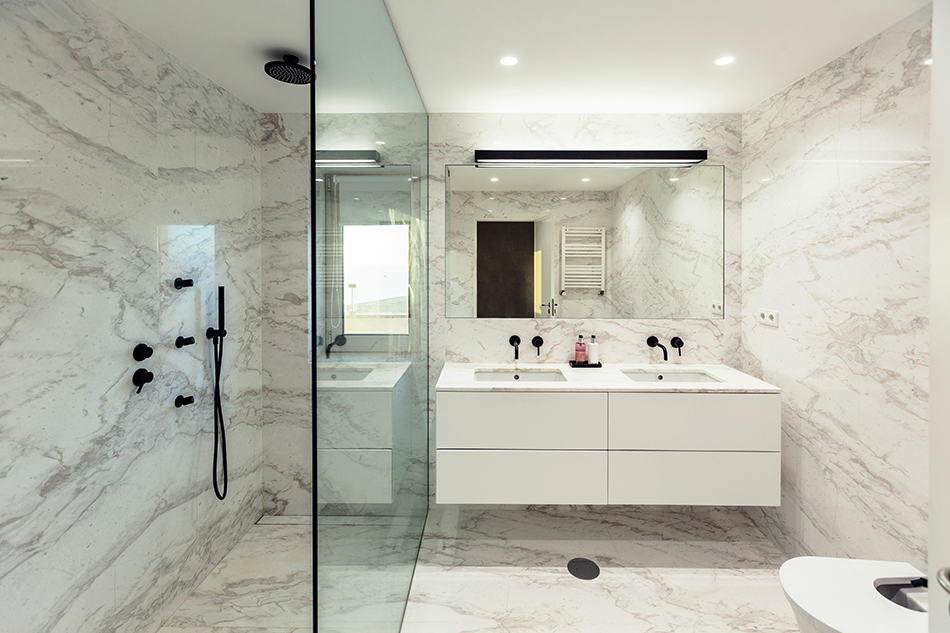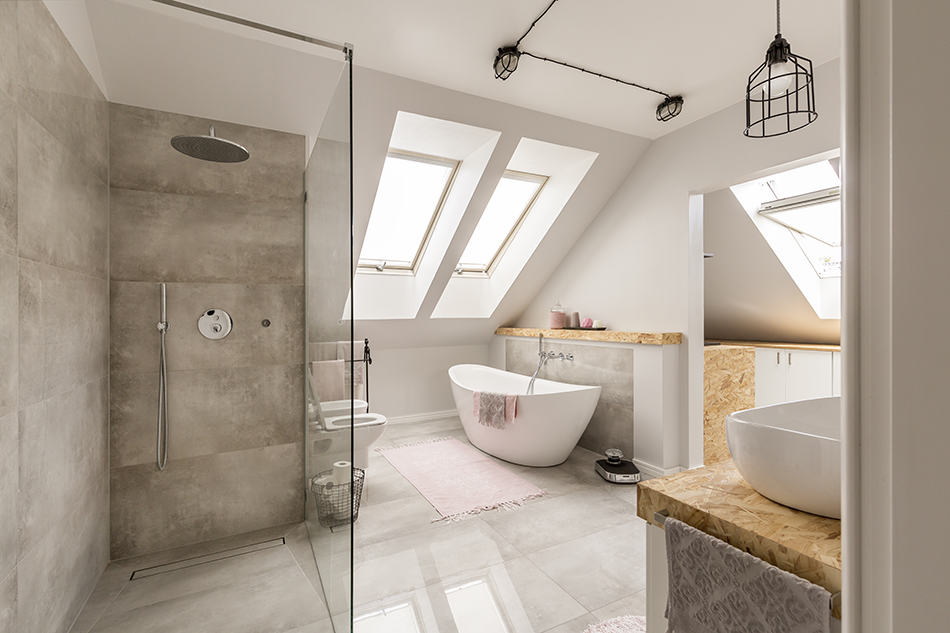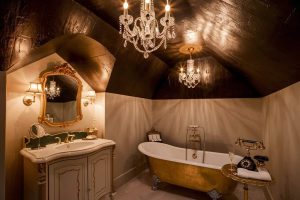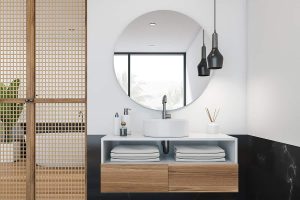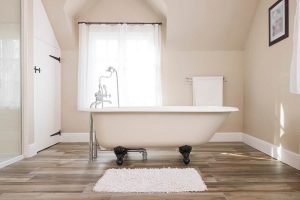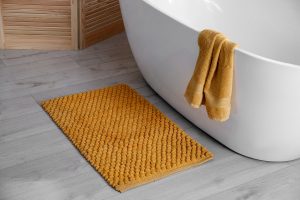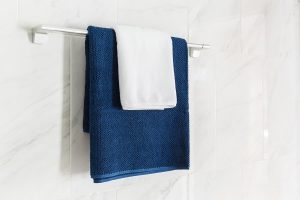If you’re investing in a bathroom renovation, you might want to investigate the option of installing a wet bathroom. Here we look at exactly what a wet bathroom involves and the pros and cons of a wet bathroom.
What is a Wet Bathroom?
A wet bathroom might also go by the name of simply ‘wet room.’ It is a bathroom in which all of the surfaces are waterproof and can therefore be simply wiped down. As the surfaces in a wet bathroom are all waterproof, the room can be open plan and remove the need for a shower screen or curtain.
A shower tray will also not be needed because the tiled floor works as the base of the shower, with a drain fitted directly into the floor tiles. The tiles will be slightly angled in a downward direction to encourage water to flow toward the drain.
Pros:
Accessibility
Although wet bathrooms are not typically designed with accessibility in mind, they actually make a great choice of a bathroom for anyone with mobility issues or for families with children. This is because a wetroom does not require a shower tray, and instead, the floor tiles in the room are all level, with some slightly angled downwards for drainage.
Wet bathrooms also do not require glass shower panels or doors, and so the shower area can be completely open. This makes the space much more convenient for someone in a wheelchair or makes it easier to access for anyone with restricted movement.
It also makes cleaning young children easier because there will be space for you to assist them or for them all to be showered at the same time. There’s also less chance of anyone getting injured or breakages occurring, as there will be no confined shower cubicles or glass doors to bang into.
Easy Cleaning
The fact that all surfaces in a wet bathroom are waterproof makes this type of room the easiest space to clean in the whole house. You can spray bathroom cleaning products on the walls, the floors, and other surfaces and wipe them down with a cloth or hose them down with a handheld shower.
All of the water in the wet bathroom will be directed towards the drain plug, and the surfaces can air dry naturally or be wiped over with a dry cloth if you’re in a hurry for the room to be dry.
This method of cleaning is quicker and easier compared to cleaning a regular bathroom, saving you time and hassle. All of the surfaces being waterproof will also minimize the chance of any leaks occurring or mold growing behind the walls.
Design Options
Wet bathrooms are much more open-plan compared to standard bathrooms because they don’t require shower curtains, shower cubicles, shower panels, or shower doors, and therefore the design of the space doesn’t have to be planned around these items.
If you have a shower door that opens outwards, you would ordinarily have to plan around this to make sure there is enough clearance in the room, whereas this won’t be necessary for a wet bathroom, so you can have items in the bathroom positioned closer together, which can make all the difference in a small space.
The layout in a wet bathroom is much less restrictive than a standard bathroom, allowing you to truly design the bathroom of your dreams.
Add Value
Wet bathrooms have been common in European countries for many years but have only recently become popular in North America. They are very on-trend right now and give off luxury hotel vibes.
This means that wet bathrooms appeal to buyers, and they can make your property stand out from others. They can also add value to your home because they are a desirable feature.
Maximize Space
If you have a small bathroom, then turning it into a wet bathroom will help to maximize the space. By removing physical elements like shower doors which serve as visual blockades, the room will be more open with broader sightlines which gives the illusion of a bigger space.
As well as creating the illusion of more space, a wet bathroom also allows you to actually fit more into the space because there won’t be bulky shower trays and other fittings taking up space. The components of a wet bathroom are much more minimal, which means you can free up space to fit in a larger vanity unit or other features.
Stylish
Wet bathrooms have a very modern look due to the fact that they are quite streamlined with sleek fixtures and fittings. This type of style works well in a whole range of homes, from minimalist to industrial.
Wet bathrooms tend to have a luxury appeal which can make your bathroom feel like a relaxing haven rather than a functional space.
Cons:
Everything Could Get Wet
One issue with wet bathrooms is the obvious fact that everything in the room has a chance of getting wet. The lack of shower screens or shower curtains in a wet bathroom means that water can end up literally anywhere. Even though water flows downwards from a rainfall shower, it can still rebound off your body and end up in places you didn’t intend.
Although every surface in a wet bathroom is designed to be waterproof, there will, of course, be elements in the bathroom that you would rather remain dry, such as towels and toilet rolls.
There are ways to work around this; you just have to be mindful with dry items. For example, you could keep your dry towels in a hamper and store toilet tissue in a cupboard. You’ll also need to remember not to keep fabric items in the room, such as a robe hanging on the door or clothes folded nearby. Avoid using any soft furnishings in a wet bathroom, including curtains or fabric blinds.
It’s not just fabric items getting wet that might bother you, but also other surfaces which will not get ruined if wet but can make using the bathroom inconvenient.
For example, going to use the toilet and finding that there’s a puddle on the toilet seat might be frustrating, and you could find that the bathroom floor is still wet after someone else in the household has just had a shower.
Dispersed Steam
The concept of a wet bathroom is that it is open plan, and therefore when having a shower, you won’t be in a confined space behind a screen as you would in a shower cubicle or when using a shower curtain. The drawback of this with regards to steam is that the steam from the hot shower gets dispersed around the whole room rather than being contained within the shower area.
This means that you won’t be able to enjoy a steamy shower or enjoy the benefits of steam inhalation when your respiratory airways are a little bunged-up. The dispersed steam will mean that your shower environment may not be as hot as usual.
Lack of Privacy
If you have only one bathroom in your household, then you may have grown accustomed to sharing the bathroom. For instance, one person might be in the shower behind the curtain while another person brushes their teeth at the basin.
In a wet bathroom, there will be no frosted glass screens or shower curtains protecting your privacy, so if you aren’t in the habit of being naked around other family members, then this could cause a problem and a queue at the bathroom door!
Non-Shower Users Could Get Wet
The main problem with wet bathrooms in a family environment is that when one person is using the shower, nobody else can use the room for fear of getting wet.
The shower curtain doesn’t just provide the user with privacy, but it also acts as a shield to stop water from splashing on the rest of the room. If parents want to supervise young children while in the shower, this could prove difficult because they are likely to get splashed with water while their children wash themselves.
Cost
Depending on what pieces of equipment you install in your wet bathroom, you might find that it is more expensive compared to if you had installed an ordinary bathroom. This is because the walls need to be fitted with a waterproof membrane, and the tiles are applied on top of this. Every wall in the bathroom, along with the floor, will need to be fully tiled or fitted with waterproof material.
Compared with a regular bathroom which may only be tiled to waist height or just has tiles behind the bath and shower, a lot more tiles will be required, which can make the cost mount up.
The larger the room and, therefore, the greater the surface area there is to cover in tile, the higher the cost will be. However, you can weigh this up against the amount of money you have saved on other fittings which you don’t need in a wet bathroom, such as a shower tray and shower curtain.
